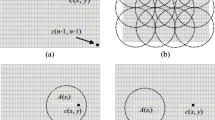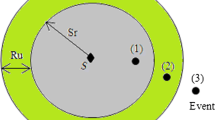Abstract
The coverage and connectivity are the two imperative performance metrics for the growth of wireless sensor networks (WSNs) with sprouting technologies. In order to maintain these metrics, the issue of finding and healing of coverage hole is closely related to these two facts and plays a vital role in the performance improvement of the network. Many works in the past explored for 2D-WSNs, but now the time has come to investigate this matter for 3D-WSNs to reach the new heights of research and technology. In this paper, different scenarios with respect to the deployment of sensor nodes or network topology with the presence of different shaped coverage holes are discussed. Not only this, to heal these perceived holes introduction of sensor nodes having sensing radius different from initial deployed sensors has been suggested which in turn outlines the development of heterogeneous sensor networks, a keen issue with respect to technology development. This deployment of sensors to constitute heterogeneous sensor networks also influences the overall network cost in terms of cost reduction with an optimum coverage level. A mathematical analysis to give a relationship between the radii of former and later deployed sensor nodes is presented in the form of theorem. At the end, the results and discussion in order to achieve a specified level of coverage with respect to different packing patterns based on the mathematical analysis are provided. Also, some future directions to guide the researchers are discussed in this paper.











Similar content being viewed by others
References
Ma, H. C., Sahoo, P. K., & Chen, Y. W. (2011). Computational geometry based distributed coverage hole detection protocol for the wireless sensor networks. Journal of Network and Computer Applications, 34, 1743–1756.
Sangwan, A., & Pal Singh, R. (2015). Survey on coverage problems in wireless sensor networks. Wireless Personal Communications, 80(4), 1475–1500.
Boufares, et al. (2016). Three dimensional mobile wireless sensor networks redeployment based on virtual forces. IEEE IWCMC, 1–7.
Ammari, H. M., & Das, S. (2009). Critical density for coverage and connectivity in three-dimensional wireless sensor networks using continuum percolation. IEEE Transaction on Parallel and Distributed Systems, 20(6), 872–885.
Ammari, H. M., & Das, S. (2010). A study of k-coverage and measures of connectivity in 3D wireless sensor networks. IEEE Transactions on Computers, 59(2), 243–257.
Babaie, S., & Sajad Pirahesh, S. (2012). Hole detection for increasing coverage in wireless sensor network using triangular structure. International Journal of Computer Science Issues, 9(1), 213–218.
Kang, Z., Yu, H., & Xiong, Q. (2013). Detection and recovery of coverage holes in wireless sensor networks. Journal of Networks, 8(4), 822–828.
Mohan Kumar, C., Gjessynirmal, A., & Patra, P. S. K. (2015). Hole detection and healing in wireless sensor network. International Journal of Emerging Technology in Computer Science & Electronics, 13(1), 79–84.
Xiao, et al. (2014). A novel deployment scheme based on three-dimensional coverage model for wireless sensor networks. The Scientific World Journal, 1–7.
Kumar, S., & Klobiyal, D. (2013). Sensing coverage prediction for wireless sensor networks in shadowed and multipath environment. The Scientific World Journal, 2013, 1–11.
Gross, J. L., & Yellen, J. (2006). Graph theory and its applications (pp. 316–317). Boca Raton: Chapman & Hall/CRC.
Acknowledgements
The authors wish to thank Dr. Poonam Mor, Assistant Professor (Department of Language and Haryanvi Culture, CCSHAU, Hisar) for her assistant in editing the content, that greatly improved the presentation quality of the article.
Author information
Authors and Affiliations
Corresponding author
Rights and permissions
About this article
Cite this article
Sangwan, A., Singh, R.P. Coverage Hole Detection and Healing to Enhance Coverage and Connectivity in 3D Spaces for WSNs: A Mathematical Analysis. Wireless Pers Commun 96, 2863–2876 (2017). https://doi.org/10.1007/s11277-017-4328-7
Published:
Issue Date:
DOI: https://doi.org/10.1007/s11277-017-4328-7




